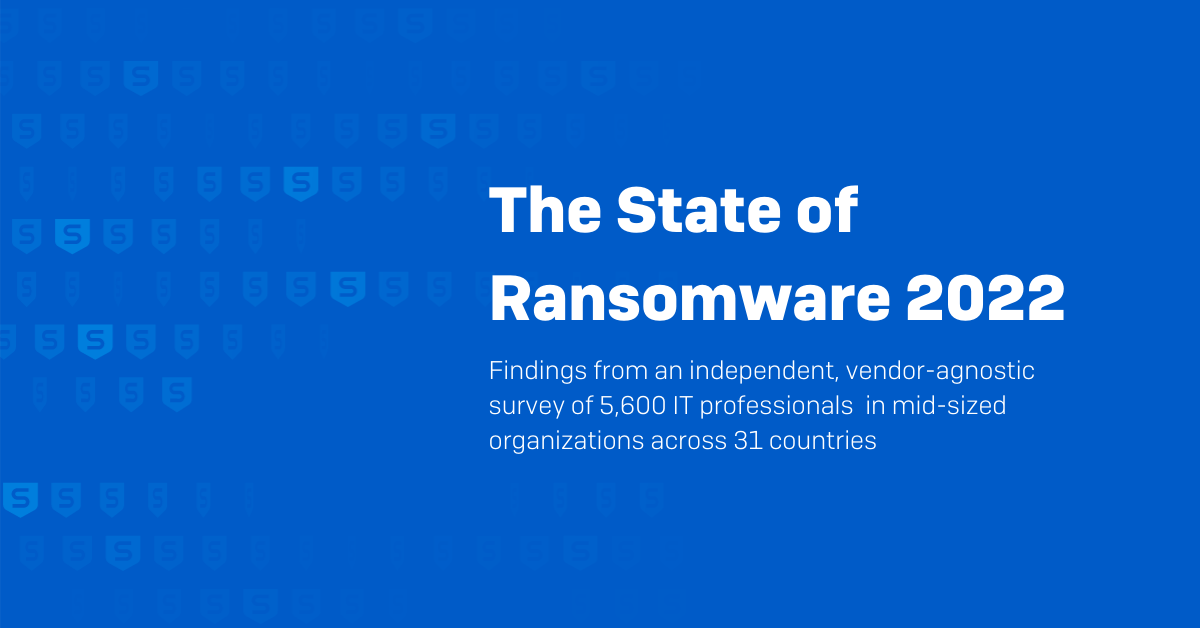The State of Ransomware 2022

Credit to Author: Sally Adam| Date: Wed, 27 Apr 2022 13:48:59 +0000
Today Sophos has released the State of Ransomware 2022, its annual study of the real-world ransomware experiences of IT professionals working at the frontline around the globe.
The study has revealed an ever more challenging attack environment together with the growing financial and operational burden ransomware places on its victims. It also shines new light on the relationship between ransomware and cyber insurance, and the role insurance is playing in driving changes to cyber defenses.
This year, 5,600 IT professional from 31 countries participated in the research, with 965 sharing details of ransom payments made. Key findings include:
- Ransom attacks are more frequent – 66% of organizations surveyed were hit with ransomware in 2021, up from 37% in 2020
- Ransom payments are higher – In 2021, 11% of organizations said they paid ransoms of $1 million or more, up from 4% in 2020, while the percentage of organizations paying less than $10,000 dropped to 21% from 34% in 2020. Overall, the average ransom paid by organizations that had data encrypted in their most significant ransomware attack, increased nearly fivefold to reach $812,360
- More victims are paying the ransom – In 2021, 46% of organizations that had data encrypted in a ransomware attack paid the ransom. Twenty-six percent of organizations that were able to restore encrypted data using backups in 2021 also paid the ransom
- The impact of a ransomware attack can be immense – The average cost to recover from the most recent ransomware attack in 2021 was $1.4 million. It took on average one month to recover from the damage and disruption. 90% of organizations said the attack had impacted their ability to operate, and 86% of private sector victims said they had lost business and/or revenue because of the attack
- Many organizations rely on cyber insurance to help them recover from a ransomware attack – 83% of mid-sized organizations had cyber insurance that covers them in the event of a ransomware attack
- Cyber insurance almost always pays out – In 98% of incidents where the victim had cyber insurance that covered ransomware, the insurer paid some or all the costs incurred (with 40% overall covering the ransom payment)
- 94% of those with cyber insurance said that their experience of getting it has changed over the last 12 months, with higher demands for cybersecurity measures, more complex or expensive policies and fewer organizations offering insurance protection
“The findings suggest we may have reached a peak in the evolutionary journey of ransomware, where attackers’ greed for ever higher ransom payments is colliding head on with a hardening of the cyber insurance market as insurers increasingly seek to reduce their ransomware risk and exposure,” said Chester Wisniewski, principal research scientist at Sophos.
“In recent years, it has become increasingly easy for cybercriminals to deploy ransomware, with almost everything available as-a-service. Second, many cyber insurance providers have covered a wide range of ransomware recovery costs, including the ransom, likely contributing to ever higher ransom demands. However, the results indicate that cyber insurance is getting tougher and in the future ransomware victims may become less willing or less able to pay sky high ransoms. Sadly, this is unlikely to reduce the overall risk of a ransomware attack. Ransomware attacks are not as resource intensive as some other, more hand-crafted cyberattacks, so any return is a return worth grabbing and cybercriminals will continue to go after the low hanging fruit.”
To learn more, read the State of Ransomware 2022.
About the study
Sophos commissioned research agency Vanson Bourne to conduct an independent, vendor-agnostic survey of 5,600 IT professionals in mid-sized organizations (100-5,000 employees) across 31 countries. The survey was conducted during January and February 2022, and respondents were asked to respond based on their experiences over the previous year. Respondents were from Australia, Austria, Belgium, Brazil, Canada, chile, Colombia, Czech Republic, France, Germany, Hungary, India, Israel, Italy, Japan, Malaysia, Mexico, Netherlands, Nigeria, Philippines, Poland, Saudi Arabia, Singapore, South Africa, Spain, Sweden, Switzerland, Turkey, UAE, UK, and US.